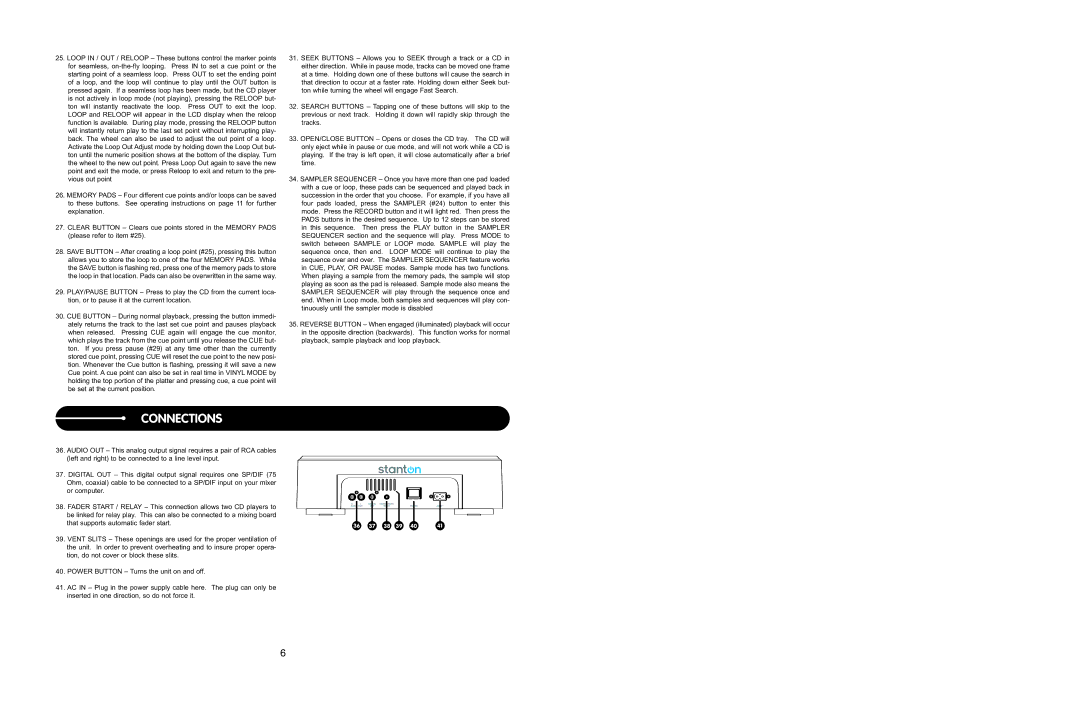25.LOOP IN / OUT / RELOOP – These buttons control the marker points for seamless, on-the-fly looping. Press IN to set a cue point or the starting point of a seamless loop. Press OUT to set the ending point of a loop, and the loop will continue to play until the OUT button is pressed again. If a seamless loop has been made, but the CD player is not actively in loop mode (not playing), pressing the RELOOP but- ton will instantly reactivate the loop. Press OUT to exit the loop. LOOP and RELOOP will appear in the LCD display when the reloop function is available. During play mode, pressing the RELOOP button will instantly return play to the last set point without interrupting play- back. The wheel can also be used to adjust the out point of a loop. Activate the Loop Out Adjust mode by holding down the Loop Out but- ton until the numeric position shows at the bottom of the display. Turn the wheel to the new out point. Press Loop Out again to save the new point and exit the mode, or press Reloop to exit and return to the pre- vious out point
26.MEMORY PADS – Four different cue points and/or loops can be saved to these buttons. See operating instructions on page 11 for further explanation.
27.CLEAR BUTTON – Clears cue points stored in the MEMORY PADS (please refer to item #25).
28.SAVE BUTTON – After creating a loop point (#25), pressing this button allows you to store the loop to one of the four MEMORY PADS. While the SAVE button is flashing red, press one of the memory pads to store the loop in that location. Pads can also be overwritten in the same way.
29.PLAY/PAUSE BUTTON – Press to play the CD from the current loca- tion, or to pause it at the current location.
30.CUE BUTTON – During normal playback, pressing the button immedi- ately returns the track to the last set cue point and pauses playback when released. Pressing CUE again will engage the cue monitor, which plays the track from the cue point until you release the CUE but- ton. If you press pause (#29) at any time other than the currently stored cue point, pressing CUE will reset the cue point to the new posi- tion. Whenever the Cue button is flashing, pressing it will save a new Cue point. A cue point can also be set in real time in VINYL MODE by holding the top portion of the platter and pressing cue, a cue point will be set at the current position.
CONNECTIONS
36.AUDIO OUT – This analog output signal requires a pair of RCA cables (left and right) to be connected to a line level input.
37.DIGITAL OUT – This digital output signal requires one SP/DIF (75 Ohm, coaxial) cable to be connected to a SP/DIF input on your mixer or computer.
38.FADER START / RELAY – This connection allows two CD players to be linked for relay play. This can also be connected to a mixing board that supports automatic fader start.
39.VENT SLITS – These openings are used for the proper ventilation of the unit. In order to prevent overheating and to insure proper opera- tion, do not cover or block these slits.
40.POWER BUTTON – Turns the unit on and off.
41.AC IN – Plug in the power supply cable here. The plug can only be inserted in one direction, so do not force it.
31.SEEK BUTTONS – Allows you to SEEK through a track or a CD in either direction. While in pause mode, tracks can be moved one frame at a time. Holding down one of these buttons will cause the search in that direction to occur at a faster rate. Holding down either Seek but- ton while turning the wheel will engage Fast Search.
32.SEARCH BUTTONS – Tapping one of these buttons will skip to the previous or next track. Holding it down will rapidly skip through the tracks.
33.OPEN/CLOSE BUTTON – Opens or closes the CD tray. The CD will only eject while in pause or cue mode, and will not work while a CD is playing. If the tray is left open, it will close automatically after a brief time.
34.SAMPLER SEQUENCER – Once you have more than one pad loaded with a cue or loop, these pads can be sequenced and played back in succession in the order that you choose. For example, if you have all four pads loaded, press the SAMPLER (#24) button to enter this mode. Press the RECORD button and it will light red. Then press the PADS buttons in the desired sequence. Up to 12 steps can be stored in this sequence. Then press the PLAY button in the SAMPLER SEQUENCER section and the sequence will play. Press MODE to switch between SAMPLE or LOOP mode. SAMPLE will play the sequence once, then end. LOOP MODE will continue to play the sequence over and over. The SAMPLER SEQUENCER feature works in CUE, PLAY, OR PAUSE modes. Sample mode has two functions. When playing a sample from the memory pads, the sample will stop playing as soon as the pad is released. Sample mode also means the SAMPLER SEQUENCER will play through the sequence once and end. When in Loop mode, both samples and sequences will play con- tinuously until the sampler mode is disabled
35.REVERSE BUTTON – When engaged (illuminated) playback will occur in the opposite direction (backwards). This function works for normal playback, sample playback and loop playback.

